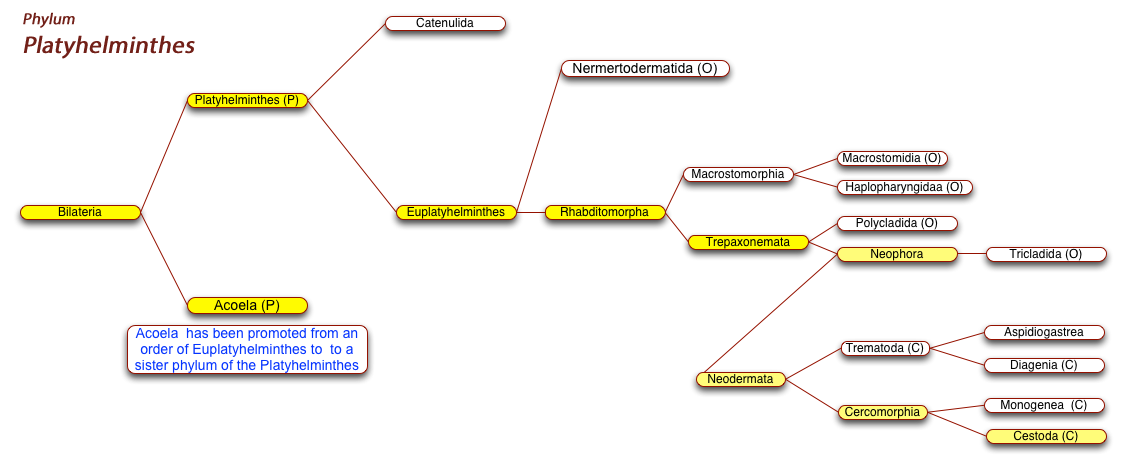
- Phylum Acoelomorpha
- Phylum Platyhelminthes (Small marine flatworms. Mouth and sometimes a pharynx present, but no digestive cavity. No protonephridia. Gonads may not be bounded by a cellular wall. Oviducts absent; entolecithal ova. Amphiscolopus, Anaperus, Afrontia, Convoluta, Haplogonaria, Polychoerus). Divided into microturbellaria and macroturbellaria based on size
- Class Turbellaria* (predominatly free living and aquatic; unsegmented; mouth leads to a stomatodeal pharynx of taxonomic significance)
- Order Nemertodermatida (Small marine flatworms similar to acolomorphaa but posessing uniflagellated sperm and an epithelial digestive tract mouth and pharynx present or absent but when present simple; entolecithal ova. Flagelophora, Meara, Nemertoderma)
- Order Catenulida (Mostly small elongated fresh water species having a simple pharynx and ciliated saclike digestive cavity. Unpaired gonads, with male gonopore dorsal above the pharynx. No female gonoducts. Entolecithal ova. Catenula, Paracatenula, Stenostomuum)
- Order Macrostomida (Small interstitial marine and fresh water species with a simple saclike ciliated digestive cavith and a simple pharynx, and one pair of ventrolateral nerve chords. Entolecithal ova. Macrostomum, Microstomum))
- Order Lecithoepitheliata (Marine and freshwater species in which the ovary produces eggs surrounded by follicle-like yolk cells. Mouth and complex pharynx at the anterior end of the body. Intes tine simple. Intermediate between ento and extolecthial condition Gnosonesima, Prorhynchus)
- Order Rhabdocoela (A large group of marine and fresh water turbellarians, having a bulbous pharynx, a simple intestine, and one pair of nerve chords. Ectolecthial ova.
- Order Prolecithophora (Small marine or fresh water species having a plicate or bulbous pharynx and a simple intestine. Ovary pro duces eggs and folliclesss-like yolk cells. Plagiostomum, Urostomium)
- Order Proseriata (Small mostly marine turbellarians including many interstitial forms. Pharynx is plicate and tubular, but the gut is not branched. Otoplana, Nemertoplana)
- Order Tricladida* (Relativly large marine and freshwater and terrestrial turbellarians. Pharynx is plicate, tubular, and posteriorly directed; gut has three branches. Bdelloura, Planaria*, Dendrocoelum, Dugesia*, Geoplana)
- Order Polycladida (Marine flatworms of moderate size with a greatly flattened more or less oval shape. Intestine elongate and centrally located, with many highly branched diverticula. Plicate pharynx. Numerous eyes and sometimes tentacles. Eurylepta, Hoploplana, Gnesiocerous, Leptoplana, Planocera, Pseudocerous, Stylorcus, Tysanozoon)
- Neodermata
- Class Monogenea* ( The parasitic flukes with simple life cycles. Body flatened and leaflike bearing a terminal mouth with oral suckers. Posterior holdfast or opisthaptor present. Mostly marine ectoparasites few endoparasitic on ectotherms.)
- Class Diagenea* With 2 or 3 hosts first a mollusc final a vertebrate. Oral and usually ventral suckers present. Echinostoma, Fasciola*, Microphalus, Opisthorchis* = Clonorchis, Sanguinicola, Schistosoma*.
- Class Cestoda* The Tapeworms. All endoparasitic with body covered with tegument. All show complete absence of a digestive tract. (Taenia*)
- Phylum Nemertea* (Rhynchocoela) Nemertians. Long, dorsoventrally flattened body complex proboscus apparatus. Marine few freshwater and terrestrial (Cerabratulus*)
- Class Anopla (Unarmed nemertians. Mouth located below or posterior to the brain.)
- Class Enopla (Armed Nemerteans. Mouth located anterior to the brain. Nerve cords located inside body wall musculature composed of an outer circular and inner longidudinal layer)
-
October 7, 2013

